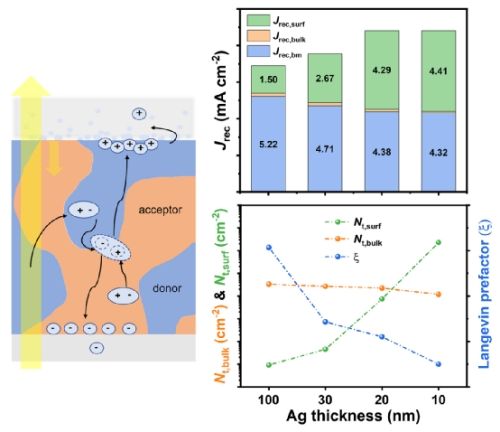Solar energy, as one of the popular clean energy sources, has experienced tremendous growth in recent years. Among the various research and development areas, organic photovoltaics have become a hot topic due to their advantages such as lightweight, semi-transparency, thinness, and flexibility. Semi-transparent organic photovoltaics find wide applications in scenarios like photovoltaic-integrated buildings, agricultural greenhouses, smart windows, making it a crucial research direction within organic photovoltaics.There is a delicate balance between the visible light transmittance and the photoelectric conversion efficiency in semi-transparent organic photovoltaics, and the efficiency of semi-transparent devices is lower than opaque ones. Therefore, investigating the optical and electrical losses during the transition from opaque to semi-transparent devices holds significant research significance for improving the efficiency of semi-transparent devices.Recently, the team led by Researcher Cheng Pei, Associate Researcher Wang Jiayu, and Dr. Yan Cenqi from our university published a research paper titled "Optical and electrical losses in semitransparent organic photovoltaics" in Joule,the sister journal of Cell.(https://doi.org/10.1016/j.joule.2023.12.011)

Semitransparent organic photovoltaics (STOPVs) allow for low-cost, sustainable, and integrated energy harvesting solutions. To promote STOPVs to reach the theoretical limit efficiency, it is necessary to clarify the optical and electrical losses during the transition from opaque to semitransparent devices. In this paper, we first calculate the photon and photocurrent losses of STOPVs relative to opaque devices and demonstrate the presence of additional current loss in STOPVs. Then, a quantitative analytical model is used to assess the current loss and charge recombination processes in STOPVs. Capacitance spectroscopy is used to decouple the recombination current densities in STOPVs to bimolecular, bulk-trap-assisted, and surface-trap-assisted components. As the thickness of the silver electrode reduces, the devices show lower Langevin prefactors, comparable bulk trap densities, and significantly increased surface trap densities, indicating that surface-trap-assisted recombination is the main current loss pathway in STOPVs.(Summary)

In addition, the team has recently published a series of achievements in semi-transparent organic photovoltaics in journals such as Chemical Society Reviews (http://dx.doi.org/10.1039/D3CS00233K), Angewandte Chemie International Edition (https://doi.org/10.1002/anie.202307622), and Advanced Functional Materials (https://doi.org/10.1002/adfm.202313594). Researcher Cheng Pei, Associate Researcher Wang Jiayu, and Associate Researcher Yan Cenqi serve as corresponding authors for these papers, with Sichuan University being the first affiliation.
The series of research achievements received support from the National Natural Science Foundation of China, the Science and Technology Department of Sichuan Province, the Science and Technology Department of the Tibet Autonomous Region, and the State Key Laboratory of Polymer Materials Engineering.



https://doi.org/10.1016/j.joule.2023.12.011
http://dx.doi.org/10.1039/D3CS00233K
https://doi.org/10.1002/anie.202307622
https://doi.org/10.1002/adfm.202313594
